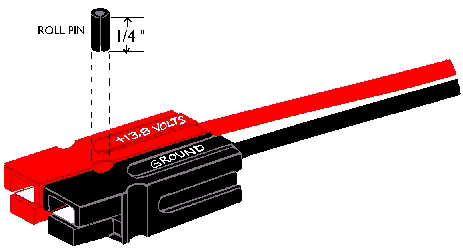|
Anderson
PowerPole 15/30 Amp Connector
The recommended configuration
is shown above. PowerWerx
recommends that the housings should be mated according to the diagram
above, viewing from the contact side (opposite the wire side),
tongue down, hood up, RED on the LEFT, BLACK on the RIGHT. See
the picture above. Don't mess this up. Wiring your connectors backwards
may not cause you a problem but if you take your equipment to use on
someone else's power source, you'll burn it up! You could also burn
THEIR equipment up! Be sure to assemble all of the connector bodies as shown to insure proper polarity and compatibility with others in the group. If you take the time to pre-assemble the connector bodies per the pictorial above, as you receive your shipment, you will find it much easier to assemble the connectors for use. Soldering the connections is recommended. If you decide to crimp the spade lug to the wire, insure that you re-form the crimped portion to "round". This will allow easy insertion into the plastic connector body. Soldering without crimping makes for easy reuse of the connectors. Highly conductive silver-plated copper contacts allow minimal contact resistance at high currents. Self-wiping action on make and break keeps conducting surfaces clean. Contact dents keep connectors mated in high-vibration applications and provide quick-break, snap action upon disconnect. Non-corrosive stainless-steel leaf springs maintain constant contact pressure—ideal for frequent connections/disconnections and intermittent overloading. Durable, high impact-resistant, polycarbonate housing with UL94V-2 flammability ratings comes in many colors for circuit trace ability and coding. Identical connector halves are genderless—making assembly quick and easy and reducing the number of parts stocked. Molded-in dovetails allow for customized harness in a variety of configurations. The 30-ampere contacts are designed for 12-16 AWG wire. The contacts can be soldered or crimped to wires. After a contact has been attached to a wire, it should be installed into the housing so that the housing spring mates with the underside of the contact. When you slide it completely in the housing you should hear a click when it passes the spring detent. To remove a contact from the housing, use Anderson insertion/extraction tool #111038G2. You may also substitute a very small blade (jewelers screwdriver or X-Acto knife) to lift up the front of the contact slightly over the detent and pull the contact out of the rear of the housing, allowing the contact to be removed. Here are the Anderson part numbers:
Diagram used with permission of Anderson Power Products Inc. (http://www.andersonpower.com), manufacturer of the Anderson Powerpole connectors and Power Werx (http://www.powerwerx.com) the supplier. Power Werx provides quantity pricing on the web site. |
Last update November 20, 2006
